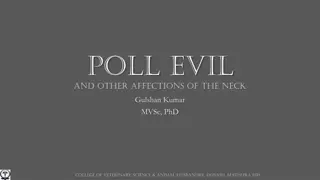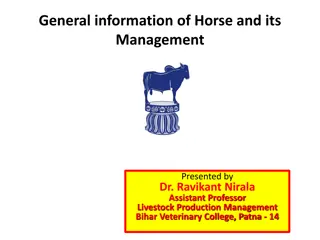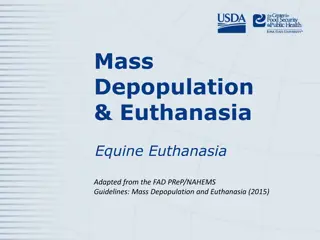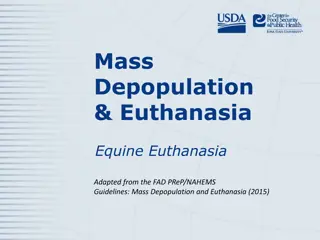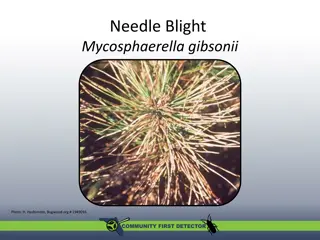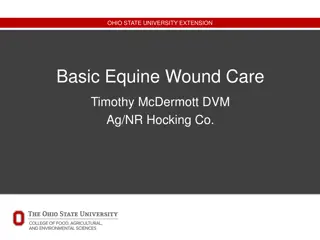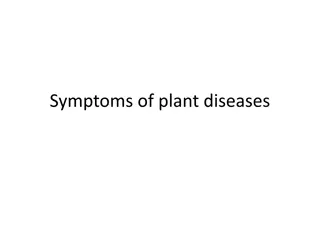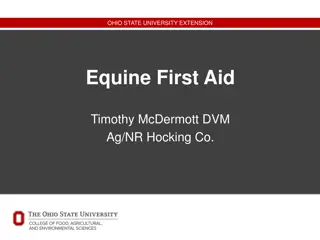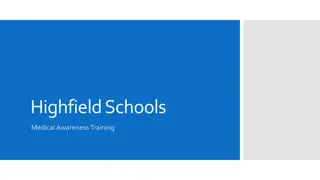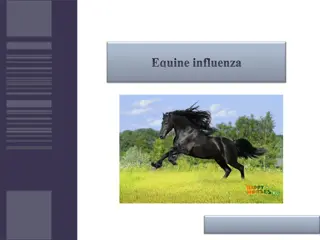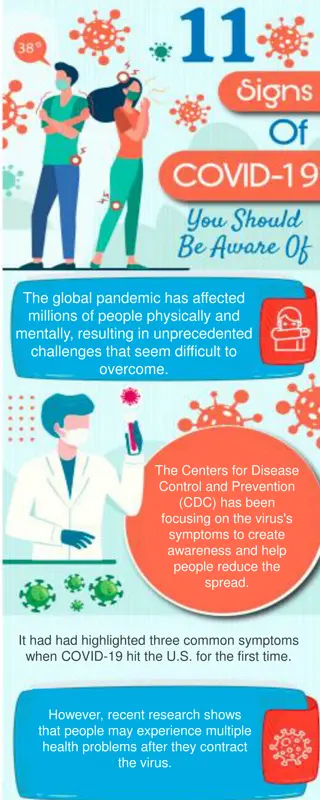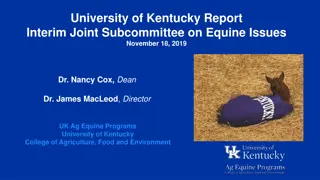Equine Coital Exanthema: Overview, Symptoms, and Management
Equine coital exanthema, caused by Equine Herpesvirus 3, is a contagious venereal disease affecting horses globally. It primarily manifests as genital lesions in stallions and mares, transmitted sexually or through contact with contaminated materials. While it is typically self-limiting, it can be painful and disrupt breeding behavior. Understanding its etiology, clinical signs, and transmission modes is crucial for effective management.
Download Presentation

Please find below an Image/Link to download the presentation.
The content on the website is provided AS IS for your information and personal use only. It may not be sold, licensed, or shared on other websites without obtaining consent from the author.If you encounter any issues during the download, it is possible that the publisher has removed the file from their server.
You are allowed to download the files provided on this website for personal or commercial use, subject to the condition that they are used lawfully. All files are the property of their respective owners.
The content on the website is provided AS IS for your information and personal use only. It may not be sold, licensed, or shared on other websites without obtaining consent from the author.
E N D
Presentation Transcript
EQUINE POX Giulia Agus
EQUINE POX Also Known As: Equine Coital Exanthema ECE Genital Horsepox Equine Venereal Balanitis Giulia Agus
Introduction Equine coital exanthema is caused by a specific herpes virus, namely Equine Herpesvirus 3 (EHV-3), a member of the large Herpesviridae the highly contagious viral venereal disease, equine coital exanthema causes genital lesions on both stallions and mares. herpesvirus 3. family, causes (ECE), which Giulia Agus
Etiology and Epidemiology It is relatively common, occurs worldwide, and in most cases is a self-limited and benign disease. It affects the genital area of the horse, and does not cause any permanent damage to the reproductive organs. It is a localized infection that does not spread systemically. Giulia Agus
Transmission Although it is primarily considered a sexually transmitted disease, has also been seen on foals feeding from dams affected, presumably transmitted by direct contact with mucous membranes or it's also possible the Iatrogenic transmission through contaminated veterinary supplies including equipment, gloves, and breeding materials. Giulia Agus
In most cases, the disease spreads during sexual contact, in fact, horses of reproductive age are usually affected. The incubation period may be less than 2 days. Giulia Agus
Clinical Signs Equine Pox causes vesicular lesions on the penis and prepuce of stallions and vulva of mares which can be extremely painful, especially to males. These lesions often suppress breeding comportment but have no direct impact upon fertility. Giulia Agus
The initial vesicles begin on the penis, spreading onto the prepuce and develop into pustules which then slough leaving ulcerated areas up to 1.5cm in diameter. These ulcers heal within a few weeks but leave depigmented scars. Giulia Agus
Systemic signs develop occasionally in stallions, affected animals exhibiting an apathetic and depressed comportment and hyperthermia. Giulia Agus
In mares, small red nodules appear on the vulva, vaginal mucosa, clitoral sinuses and perineal skin 4-8 days after breeding. Ulcers can occasionally be found on the teats, lips, nasal and oral mucosae. Giulia Agus
These develop into pustules and then vulval erosions which form scabs and then heal leaving depigmented scars. While the lesions heal, 3 weeks of sexual rest are recommended. If the mare is ready for reproduction, artificial insemination is recommended. Giulia Agus
The margins of ulcers can be viewed under electron microscopy revealing viral particles within the cells. Biopsies of lesions can also be histologically examined for viral inclusion bodies. Giulia Agus
There does not appear to be any correlation between infection and abortion. Prevention is crucial to limit contact between individuals with isolation. Giulia Agus
Diagnosis There are two laboratory methods of confirming the diagnosis: 1. sequential serology testing and 2. isolation of the virus from cultures of the genital lesions. Giulia Agus
Mares bumps in the vulva within 4-8 days after breeding. These bumps then develop into fluid filled vesicles that will rupture leaving excoriated lesions. If secondary infection develops, the lesions become purulent and drain pus. usually develop small red Giulia Agus
At times, the mares will develop fever with secondary infection. Uncomplicated lesions will usually heal within three weeks, although lesions of the vagina and clitoris may heal somewhat slower. Giulia Agus
Scarring may remain at the site of the lesions, but they will not interfere with future pregnancies or future fertility. Giulia Agus
Lesions on the stallions are similar in appearance, but are very painful. The stallion may refuse to copulate when he has active lesions, and sperm count may be affected by the bleeding of the vesicles. Giulia Agus
Treatment ECE resolves spontaneously within a few weeks, requiring no treatment but three weeks of sexual rest is recommended. Giulia Agus
A short-lived immunity then develops. Recurrence within the same breeding season is uncommon. Topical antibiotics may be used to prevent secondary infections while lesions are open and ulcerated. Giulia Agus
Control Affected stallions should be rested for at least 3 weeks after cessation of clinical signs to prevent spread to mares. Semen from such individuals may be collected and delivered via artificial insemination if permitted Giulia Agus
Thanks Thanks for for the the attention attention! ! Giulia Agus
BIBLIOGRAFIA Veterinary Medicine. Blood Radostits Henderson, Bailli re Tindal www.wagwalking.com www.wikivet.net Giulia Agus


